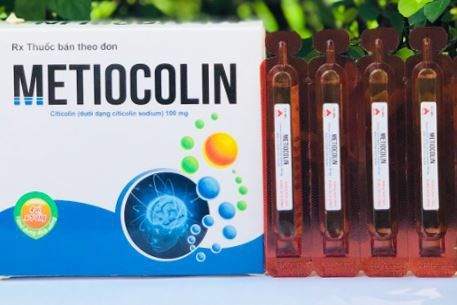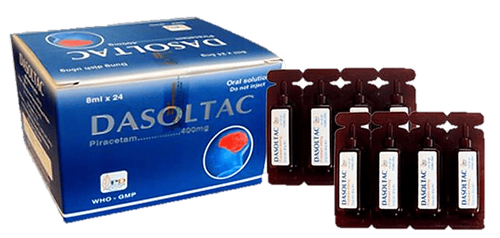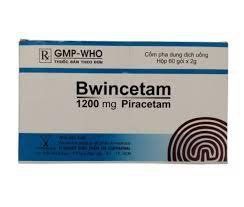This is an automatically translated article.
Fepinram is a prescription drug, administered by injection/intravenous/oral route. Fepinram belongs to the group of psychotropic drugs. Let's learn more about Fepinram's uses, how to use Fepinram 800, dosage, safety information about Fepinram,... right in this article.
1. What is Fepinram?
What is Fepinram? Fepinram is a psychotropic drug, a list of psychoactive drugs. Fepinram is manufactured by PT Ferron Par Pharm pharmaceutical company - Indonesia, registration number VN - 5059 - 07.
Fepinram has the main ingredient Piracetam and other excipients as announced by the manufacturer. The drug is prepared in 2 forms:
Solution for intravenous infusion; Film-coated tablets; The drug packaging depends on the dosage form, with Fepinram injection in a box of 1 bottle of 60ml. In tablet form, Fepinram 800 is packaged in a box of 5 blisters x 6 tablets.
2. Uses of Fepinram
Fepinram drug has the main ingredient Piracetam - a drug that improves the metabolism of nerve cells. Piracetam, the main ingredient in Fepinram 800, is a cyclic derivative of the gamma aminobutyric acid, GABA.
Fepinram acts on neurotransmitters such as:
Acetylcholine; Noradrenaline; Dopamine; ... Fepinram can change neurotransmitters, helping to improve the metabolic environment to help nerve cells work efficiently.
Experimental studies have shown that Fepinram 800 protects against ischemic metabolic disorders. To do this must be thanks to the ability to increase the brain's resistance to hypoxia.
Fepinram also increases glucose mobilization and utilization independent of oxygen supply. This helps facilitate the pentos pathway, as well as maintaining energy synthesis in the brain. In addition, Fepinram also helps release dopamine, which is very effective in memory formation. The nature of Fepinram 800 does not cause drowsiness, sedation.
Piracetam contained in Fepinram also has the effect of agglomerating urine. In cases of abnormally stiff red blood cells, Fepinram is used to help red blood cells restore their deformability and pass through the capillaries.
Fepinram is rapidly absorbed after oral/injection/intravenous infusion. Absorption is unchanged even with long-term use and renal excretion.
3. Indications for Fepinram
Fepinram is indicated for the following subjects:
Impaired cognitive function; Chronic sensory neuropathy; Cerebral ischemic sequelae; Peripheral disorders; Central brain disorders; Brain disorders (coma, disturbances of consciousness...); Traumatic brain injury and sequelae; Dizzy; Difficulty learning in children; Stroke; Hemiplegia; Ischemic; Alcoholism; Muscle tremors; ... Fepinram is indicated for the above groups of subjects. However, when using it, it must be guided, indicated, and monitored by a doctor or pharmacist.
4. Dosage – Fepinram . dosage
Because Fepinram has 2 different formulations, the method of administration and dosage are also different.
Fepinram solution for injection
Fepinram for injection / intravenous infusion . Dosage according to the manufacturer's recommendation is to inject 30-160mg/kg body weight/day divided into 2-4 times. In severe cases, the dose can be adjusted. Specifically:
Mental-organic syndrome: The recommended dosage is 2.4-4.8g divided 2-3 times/day. Myoclonic tremor originating from the cerebral cortex: Fepinram 7.2g dose can be used, then the dose can be adjusted up to 4.8g to a maximum of 20g x 2-3 times/day. If used with other anticonvulsants, the same dose should be maintained. Adjust dose according to response ability. Once started, treatment with Fepinram should be continued until the etiological encephalopathy persists. In subjects with acute attacks, the condition may improve over time. Therefore, every 6 months, it is recommended to try down-adjusting or discontinuing treatment with Fepinram. Adjust dose to 1.2 g/ 2 days or every 3 to 4 days in subjects with Lance Adams syndrome to avoid sudden relapse or seizures due to abrupt discontinuation. Dizziness: The manufacturer's recommended dose of Fepinram is 2.4 - 4.8 g x 2 - 3 times. Prevention and reduction of thromboembolic episodes in sickle cell disease: The recommended dose of Fepinram is 360 mg/kg body weight x 4 times/day. In addition, for children, the dose of Fepinram by injection / intravenous infusion also depends on each specific condition, including:
Difficulty reading: 3.4g/day x 2 times throughout the school year for children from 8 age. Prevention and reduction of thromboembolic episodes in sickle cell disease: 300mg/kg body weight/day x 4 times. Caution should be exercised when dosing Fepinram for the above subjects.
Dosage of Fepinram 300mg orally
Fepinram 800mg is made in tablet form orally. The recommended dose for adults is 800mg/day x 3 times. In case of improvement, use Fepinram 800 orally at a dose of 400mg/day x 3 times.
In addition, the usual dose of Fepinram orally is 30-160g/kg/day x 2-4 times. For specific cases, the dose is as follows:
Dosage of Fepinram 800 for psychosomatic syndromes: For long-term treatment of elderly patients with psycho-organic syndromes, the dose of Fepinram 800mg is 1.2 – 2.4g/day. High doses can be up to 4.8g/day during the first week of use. Dosage of oral Fepinram for alcoholics: 12g/day for the first time, 2.4g/day for maintenance. Dosage for patients with cognitive impairment after brain injury: Use oral Fepinram at a dose of 9-12g / day, maintain a dose of 2.4g / day for about 3 weeks Dosage for subjects with sickle cell anemia: Dosage: Oral Fepinram 160mg/day x 4 times/ Dosage for patients with myoclonus: Oral Fepinram dose is 7.2g/day x 2-3 times. Depending on the response ability to adjust the dose from 3 to 4 days / time. Oral Fepinram may be increased from 4.8 g/day to a maximum of 20 g/day.
5. Contraindications to the use of Fepinram
Do not use Fepinram for the following subjects:
Patients with hypersensitivity or allergy to the ingredients in Fepinram; Severe kidney failure; Huntington's disease; Liver failure; Pay attention to safety when using Fepinram, not for the group of subjects with contraindications.
6. Fepinram drug interactions
Fepinram drugs can cause interactions with drug groups:
Central nervous system stimulants; Psychotropic drugs; Thyroid hormone; Acenocoumarol; Alcohol; To be on the safe side, tell your doctor what medications you're taking while using Fepinram.
7. Fepinram side effects
Taking Fepinram can cause side effects including:
Restlessness; Confuse; Stimulate; Concerned; Sleep disorders; Tired; Digestive disorders; Irritation; ... In addition, with Fepinram injection, you may experience some local reactions immediately after injection such as irritation. It is necessary to monitor and notify the doctor of these manifestations when taking Fepinram to effectively manage.
8. Warnings and Precautions Fepinram
Fepinram is given some warnings and cautions by the manufacturer in subjects with renal impairment, the elderly and with epilepsy.
9. Preservation of Fepinram
Fepinram is stored at room temperature.
Fepinram belongs to the group of prescription psychoactive drugs. Fepinram has 2 different dosage forms, depending on the condition and instructions, the doctor can prescribe the appropriate drug form. If you have any other questions about Fepinram, ask your doctor/pharmacist for answers.













